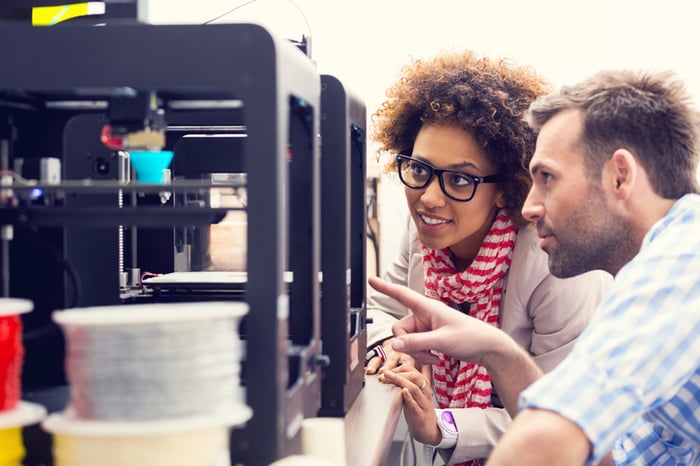Desktop Metal (DM 1.61%) is one of the few companies solely focused on 3D printing with a wide array of different substances, giving investors exclusive exposure to a high-growth niche market. Indeed, the company expects the additive manufacturing market to increase more than 11 times over, from $12 billion to $146 billion, by 2030. However, the company can't expect to survive and thrive long-term with this emerging industry if it's continually operating at a loss. Prospective investors can't ignore the fact that Desktop Metal has gone on a major buying spree, boosting its sales -- at the apparent expense of its profitability.

Image source: Getty Images.
Urge to splurge
Desktop Metal's recent revenue growth is undeniable: Q2 2021 revenue totaled $19 million, up 68% from the first quarter of 2021, and an increase of 767% over the second quarter of 2020.
Desktop Metal doesn't specify how much of its Q2 revenue was driven by its recent acquisitions. That may skew the top-line results in the company's favor, making it look like Desktop Metal's core business is stronger than it actually is.
Besides, Desktop Metal's recent series of buyouts could prove to be too much, too fast. The company has either purchased, or is in the process of purchasing, four businesses:
- Aidro, which has 40 years of experience designing and producing of valves, manifolds, and various hydraulic components and fluid power systems.
- Aerosint, whose powder deposition system supports the high-speed printing of a broad range of polymers, metals, and ceramics
- Beacon Bio, which develops 3D printing and biofabrication solutions for personalized medicine, including a promising pathway for soft-tissue regeneration
- Adaptive3D, whose printable materials are optimized for the manufacture of 3D plastic and rubber parts for a broad range of markets .
It's too soon to determine whether Desktop Metal's acquisition spree will lead to organic growth. However, the company practically admits that its buying binge is weighing on its bottom line: The Q2 net loss of $43.2 million includes $10.4 million in in-process research and development assets acquired through Beacon Bio.
The company's quarterly adjusted EBITDA of -$24.5 million further suggests that Desktop Metal's bottom line isn't ideal. Moreover, Desktop Metal seems to acknowledge that it will likely dig deeper into that hole: The company's full-year 2021 outlook calls for adjusted EBITDA in the range of -$70 million to -$80 million, and that's excluding the effects of acquiring ExOne.
All that said, Desktop Metal's gross margin, while still negative, has improved significantly over the last year, even as the company's workforce has grown, suggesting that the new acquisitions aren't bogging down the company with too many ongoing expenses.
Building the library -- and the moat
Even as it buys up intriguing businesses, Desktop Metal needs to have something to keep its competitors from swooping in and eating its lunch.
Desktop Metal's moat is threefold. First, the company already has an extensive distribution network, with over 200 partners in place in 65 countries across all inhabited contents, augmenting its product adoption, reach, and name recognition. The company had doubled its distribution network in February with Desktop Metal's acquisition of photopolymer AM company EnvisionTEC -- at least one measurable benefit of its recent acquisition spree.
On the other hand, Desktop Metal isn't unique in having a far-reaching network. The company's rival, 3D Systems (DDD 1.29%), boasts a partner network and sales specialists in over 68 countries.
Next, Desktop Metal doesn't exactly have household brand-name recognition, but it does have adoption from big-name customers like Raytheon, Lockheed Martin, General Electric, Ford, Amazon, Dow, and Adidas.
Big-name customers translate to big-time adoption. When Ford sought out cutting-edge 3D printer tech, it turned to Desktop Metal and ordered the company's latest model, the P-1. Sure, Ford could have gone with a cheaper rival, but the P-1 prints with a resolution of 1200 dpi, and prints each layer in less than three seconds -- advantages that rivals can't currently match. And if Ford likes the P-1, the company might order a bunch of Desktop Metal's forthcoming P-50 printers to mass-produce parts, instead of just testing the waters with prototypes.
In addition, the company has 300-plus issued/pending patents, and a materials library comprising more than 225 qualified materials ranging from metals to composites, polymers, ceramics, biocompatible materials, and more. In other words, competitive upstarts can't legally replicate some of Desktop Metal's innovations, and won't likely be able to match the breadth of the company's inventions.
Slow and steady wins the race
Clearly, Desktop Metal is an ambitious business in a growing niche market, with some famous customers under its belt. Yet the company needs to slow down and let its business breathe. Having robust growth plans -- and being the only tradable asset in its niche -- doesn't negate Desktop Metal's need to exercise some fiscal discipline. The company's next quarterly report should contain plenty of evidence of acquisition-driven growth -- and hopefully, no new acquisitions.
Going forward, prospective investors should watch for specifics on when Desktop Metal' acquisitions could help the company swing from a net loss to profitability. A path-to-profits timeline would be awfully nice. At this point, a teaser from the CEO would be welcome. Either way, confidence in DM stock hinges on the company's continued commitment to growth -- but not at any cost.


